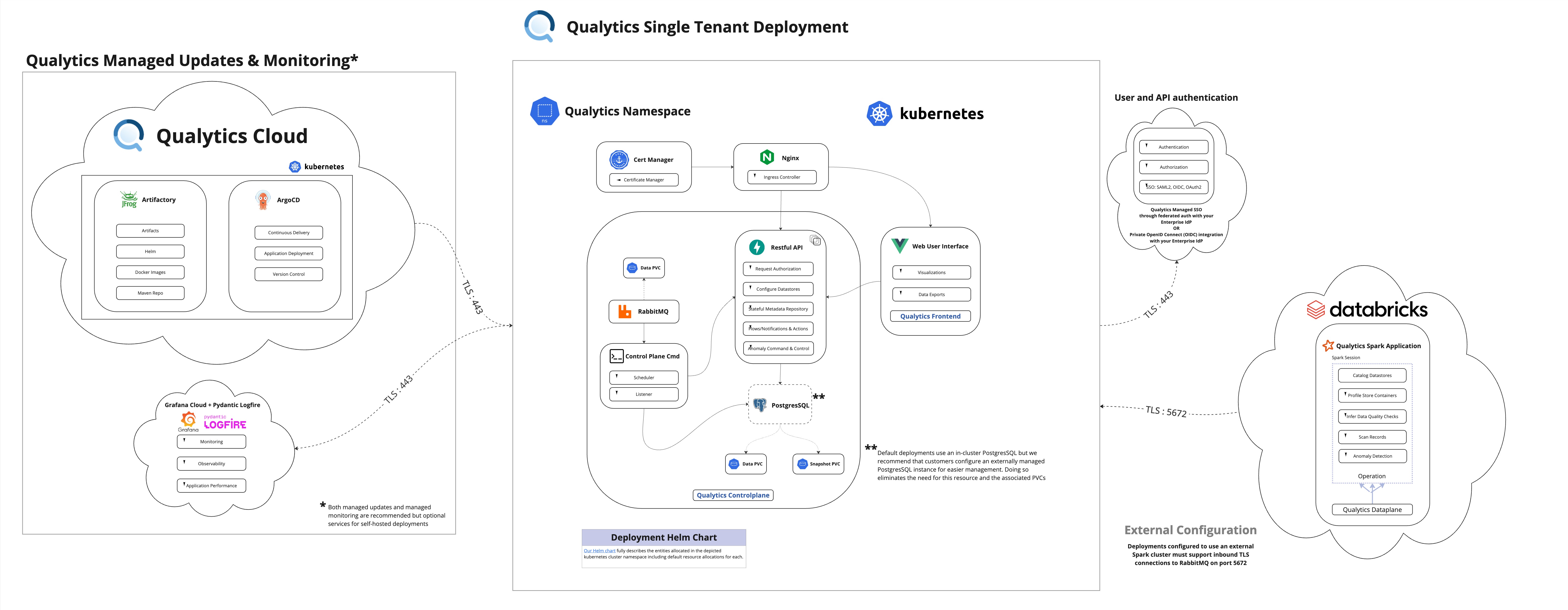Dataplane Deployment Guide for Databricks
This guide will walk you through deploying the Qualytics dataplane in your Databricks environment.
Prerequisites
Before starting the deployment, ensure you have: - Databricks CLI installed and configured - Access to your Databricks workspace with job creation permissions
Step 1: Create Secrets Scope
First, create a secrets scope to securely store sensitive information:
Step 2: Add Required Secrets
Add the following secrets to your Databricks secrets scope:
RabbitMQ Password
When prompted, enter the RabbitMQ password:[RABBIT_PASSWORD_TO_BE_PROVIDED]
Docker Hub Token
When prompted, enter the Docker Hub token:[DOCKER_TOKEN_TO_BE_PROVIDED]
Step 3: Deploy the Job
Create a file named databricks.yml with the following configuration:
resources:
jobs:
QualyticsDataplane:
name: QualyticsDataplane
continuous:
pause_status: PAUSED
tasks:
- task_key: QualyticsDataplane
spark_jar_task:
jar_uri: ""
main_class_name: io.qualytics.dataplane.SparkMothership
run_as_repl: true
job_cluster_key: QualyticsJobCluster
libraries:
- jar: file:///opt/qualytics/qualytics-dataplane.jar
job_clusters:
- job_cluster_key: QualyticsJobCluster
new_cluster:
spark_version: 17.1.x-scala2.13
spark_conf:
spark.driver.extraJavaOptions: -Dconfig.resource=prod.conf
-Djava.library.path=/databricks/libs
--add-opens=java.base/java.lang=ALL-UNNAMED
--add-opens=java.base/java.util=ALL-UNNAMED
--add-opens=java.base/java.lang.invoke=ALL-UNNAMED
--add-opens=java.base/java.nio=ALL-UNNAMED
--add-opens=java.base/sun.nio.ch=ALL-UNNAMED
--add-opens=java.management/sun.management=ALL-UNNAMED
--add-exports=java.management/sun.management=ALL-UNNAMED
-Djava.security.manager=allow
spark.executor.extraJavaOptions: -Djava.library.path=/databricks/libs
--add-opens=java.base/java.lang=ALL-UNNAMED
--add-opens=java.base/java.util=ALL-UNNAMED
--add-opens=java.base/java.lang.invoke=ALL-UNNAMED
--add-opens=java.base/java.nio=ALL-UNNAMED
--add-opens=java.base/sun.nio.ch=ALL-UNNAMED
--add-opens=java.management/sun.management=ALL-UNNAMED
--add-exports=java.management/sun.management=ALL-UNNAMED
-Djava.security.manager=allow
spark.databricks.r.command: /bin/false
spark.executorEnv.PYSPARK_PYTHON: /bin/false
spark.executorEnv.PYSPARK_DRIVER_PYTHON: /bin/false
spark.databricks.driverNfs.clusterWidePythonLibsEnabled: "false"
spark.databricks.driverNfs.enabled: "false"
spark.databricks.sql.externalUDF.env.enabled: "false"
aws_attributes:
first_on_demand: 1
availability: SPOT_WITH_FALLBACK
zone_id: auto
spot_bid_price_percent: 100
node_type_id: r6id.2xlarge
spark_env_vars:
MOTHERSHIP_NUM_CORES_PER_EXECUTOR: "8"
MOTHERSHIP_MAX_MEMORY_PER_EXECUTOR: "50000"
MOTHERSHIP_MAX_EXECUTORS: "20"
MOTHERSHIP_RABBIT_HOST: rabbitmq.us-east-1.elb.amazonaws.com
JNAME: zulu21-ca-amd64
MOTHERSHIP_RABBIT_USER: user
MOTHERSHIP_RABBIT_PASS: "{{secrets/qualytics/rabbitmq-password}}"
enable_elastic_disk: false
docker_image:
url: qualyticsai/dataplane-databricks:latest
basic_auth:
username: qualyticsai
password: "{{secrets/qualytics/docker-token}}"
data_security_mode: DATA_SECURITY_MODE_DEDICATED
runtime_engine: PHOTON
kind: CLASSIC_PREVIEW
is_single_node: false
autoscale:
min_workers: 1
max_workers: 20
queue:
enabled: true
Step 4: Deploy the Configuration
Deploy the job using the Databricks CLI:
Step 5: Start the Job
Once deployed, you can start the job from the Databricks UI or using the CLI:
Configuration Notes
- RabbitMQ Connection: The dataplane connects to
rabbitmq.us-east-1.elb.amazonaws.comwith useruser - Cluster Configuration: Uses
r6id.2xlargeinstances with autoscaling from 1-20 workers - Docker Image: Uses
qualyticsai/dataplane-databricks:latestwith provided authentication
Troubleshooting
If you encounter issues:
- Verify secrets are properly configured:
databricks secrets list-secrets qualytics - Check job logs in the Databricks UI
- Ensure the JAR file is uploaded to the correct location
- Verify network connectivity to the RabbitMQ endpoint
Support
For additional support or questions, please contact the Qualytics team.
